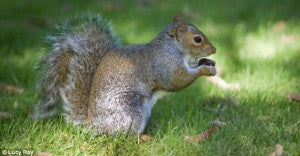Hey, Patriotic People!
The country celebrates and honors all its past presidents on this day as today is Presidents’ Day. However, this wasn’t always a day meant for celebrating our nation’s previous presidents. No, it was originally meant to celebrate just one of our presidents—the very first one we had, President George Washington.
 That’s right. Today’s holiday was actually intended to celebrate Washington’s Birthday. In fact, Presidents’ Day is sometimes still referred to as ‘Washington’s Birthday’, though George Washington’s real birthday is on February 22 (it was moved to the third Monday in February so it would always land on a Monday). Since its move, its meaning changed as well, incorporating other presidents. But because this day started with ol’ George, I thought I’d tell you some stuff you probably didn’t know about our first president.
That’s right. Today’s holiday was actually intended to celebrate Washington’s Birthday. In fact, Presidents’ Day is sometimes still referred to as ‘Washington’s Birthday’, though George Washington’s real birthday is on February 22 (it was moved to the third Monday in February so it would always land on a Monday). Since its move, its meaning changed as well, incorporating other presidents. But because this day started with ol’ George, I thought I’d tell you some stuff you probably didn’t know about our first president.
1.) First of all, despite the fact that it WAS customary for a man of his stature to have graduated college (as all his contemporaries had), George did not continue his education after the age of 16. Instead his older brother taught him the trade of land surveying and mapmaking. This became George’s occupation before that whole president-thing came along.
2.) Lots of people think that George had wooden teeth, but his dentures were ACTUALLY  made out of lead, ivory, gold, and some animal teeth. George ended up losing a lot of his own teeth in his early 20’s due to poor dental hygiene. Take it from ol’ George, kids. If you don’t brush ‘em, you won’t get to keep ‘em.
made out of lead, ivory, gold, and some animal teeth. George ended up losing a lot of his own teeth in his early 20’s due to poor dental hygiene. Take it from ol’ George, kids. If you don’t brush ‘em, you won’t get to keep ‘em.
3.) Did you know that George Washington did not want to be president? He was elected for presidency and, despite the fact that he had support for a THIRD term, it was he who made the decision to step down and let somebody else do the job. It was then set in order that presidents could only serve a maximum of two terms.
So, I hope I taught you at least a thing or two about our nation’s first president today. Happy Presidents’ Day and, as always, thanks for reading.
- John


 —it’s National Puzzle Day! A great way to pass the time on a chilly day in January, people LOVE jigsaw puzzles. Strengthening visual acuity as well as pattern recognition, puzzles are advantageous in more than one way. They were originally designed as educational tools, actually.
—it’s National Puzzle Day! A great way to pass the time on a chilly day in January, people LOVE jigsaw puzzles. Strengthening visual acuity as well as pattern recognition, puzzles are advantageous in more than one way. They were originally designed as educational tools, actually. I still remember learning my states and capitals with a simple puzzle-map of the United States. Somehow, placing the position of a state myself really locked its location in my memory. It was a great method by which to learn geography.
I still remember learning my states and capitals with a simple puzzle-map of the United States. Somehow, placing the position of a state myself really locked its location in my memory. It was a great method by which to learn geography. The late 1800’s brought about a jigsaw puzzle that was constructed from cardboard—pretty much what we all think of when we think of a jigsaw puzzle. However, despite its eventual success, manufacturers predicted that wooden puzzles weren’t budging from their place on top and that customers wouldn’t want something as cheap as a cardboard puzzle.
The late 1800’s brought about a jigsaw puzzle that was constructed from cardboard—pretty much what we all think of when we think of a jigsaw puzzle. However, despite its eventual success, manufacturers predicted that wooden puzzles weren’t budging from their place on top and that customers wouldn’t want something as cheap as a cardboard puzzle. g, car accident-causing rodents, we likely owe our entire existence to these little guys. That’s why today we’re celebrating Squirrel Appreciation Day.
g, car accident-causing rodents, we likely owe our entire existence to these little guys. That’s why today we’re celebrating Squirrel Appreciation Day. ere are over 200 different species of squirrels the world over? From tree squirrels to ground squirrels, fox squirrels, grey squirrels, FLYING squirrels (which don’t actually FLY), and many, many more, squirrels have obviously been around for quite some time in order to have developed so many differences.
ere are over 200 different species of squirrels the world over? From tree squirrels to ground squirrels, fox squirrels, grey squirrels, FLYING squirrels (which don’t actually FLY), and many, many more, squirrels have obviously been around for quite some time in order to have developed so many differences. g the brutal elements of prehistoric nature better than the dinosaurs were able to, you and I wouldn’t even be here!
g the brutal elements of prehistoric nature better than the dinosaurs were able to, you and I wouldn’t even be here!


